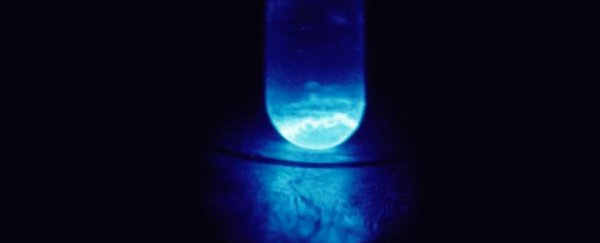Dragons lurk at the edges of the map of known elements – atomic giants so delicate, and so scarce, they defy easy study.
One such behemoth has finally given up at least some of its secrets, with chemists managing to gather just enough einsteinium to flesh out important details on the mysterious element's chemistry and ability to form bonds.
For the better part of 70 years, isotopes of einsteinium have proven frustratingly difficult to study. Either they're way too hard to make, or they have a half-life of less than a year, and what precious little is created begins to fall apart like a sandcastle at high tide.
The element's behaviour is presumed to follow the patterns of its less robust peers in the actinide series. That much is clear. But due to its sheer size, strange relativistic effects make it harder to predict how it will react in certain chemical processes.
Usually, such confusion is easily cleared up by simply conducting a run of experiments.
The US Department of Energy's Lawrence Berkeley National Laboratory has finally scooped together enough of the stuff to do just that.
More informally referred to as the Berkeley Lab, the famous institute is already responsible for the discovery of a significant chunk of the upper bounds of the periodic table of elements.
A dozen of them were the work of nuclear physicist Albert Ghiorso, a life-long Berkeley researcher whose early career saw him develop radiation detectors as part of the Manhattan Project.
In the early 1950s, Ghiorso detected faint traces of two as-yet unidentified radioactive elements in airborne dust collected by planes flying through the aftermath of the first full-scale test of a thermonuclear device.
One of those elements was later dubbed einsteinium, named after none other than the famous German-born theorist himself.
With an atomic mass of 252, and containing a whopping 99 protons, it's no lightweight. As with all transuranic elements – elements heavier than uranium – einsteinium requires some serious physics to produce.
There's no convenient source or stockpile to dip into. Cooking up a batch requires shooting smaller relatives, like curium, with a bunch of neutrons in a nuclear reactor, and then having a lot of patience.
Early efforts in the 1960s produced just enough to see with the naked eye, weighing in at a minuscule 10 nanograms. Later attempts managed a little better, though mostly resulting in impure batches.
This time, researchers came up with around 200 nanograms of the einsteinium isotope E-254, framed as part of a complex with a carbon-based molecule called hydroxypyridinone.
Getting this far wasn't easy, marred by contamination of smaller elements, and then the inevitable impact of mid- pandemic shutdown – just the thing to threaten an experiment dependent on a rapidly decaying material.
"It's a remarkable achievement that we were able to work with this small amount of material and do inorganic chemistry," says researcher Rebecca Abergel.
"It's significant because the more we understand about its chemical behaviour, the more we can apply this understanding for the development of new materials or new technologies, not necessarily just with einsteinium, but with the rest of the actinides too. And we can establish trends in the periodic table."
Subjecting their vanishing pile of chelated E-254 atoms to X-ray absorption tests and photophysical measurements revealed important details on the element's bond distance, while also demonstrating wavelength-shifting emission behaviours not seen in other actinides.
Einsteinium sits right at the edge of what we can achieve using benchwork chemistry. While larger elements exist, their increasing girth puts them out of reach of current technology's ability to create enough for analysis.
But the more we learn about heavy atoms like einsteinium, the greater the potential for finding stepping stones to constructing giants that truly lie somewhere off the map.
"Similar to the latest elements that were discovered in the past 10 years, like tennessine, which used a berkelium target, if you were to be able to isolate enough pure einsteinium to make a target, you could start looking for other elements and get closer to the (theorised) island of stability," says Abergel.
This research was published in Nature.
